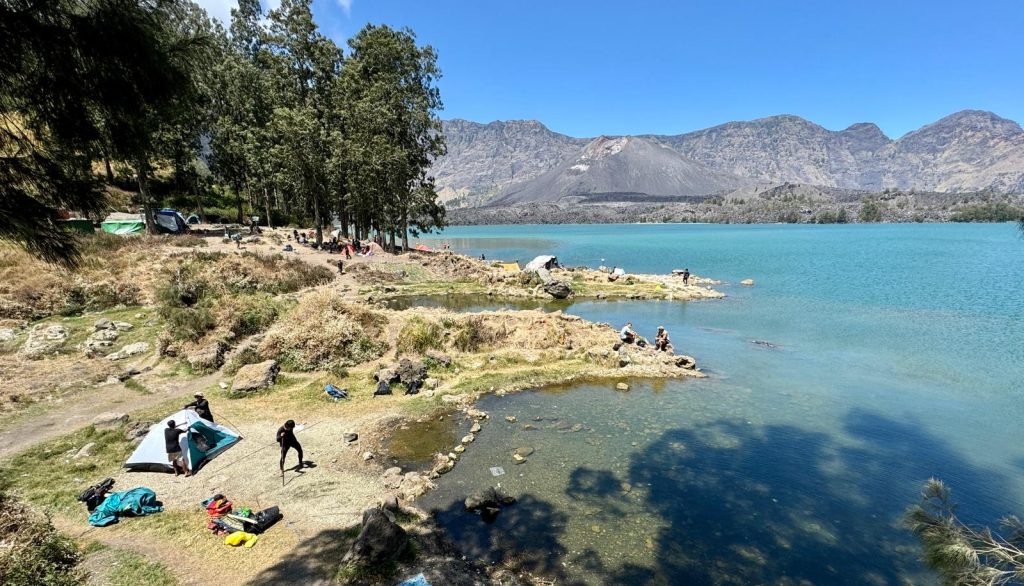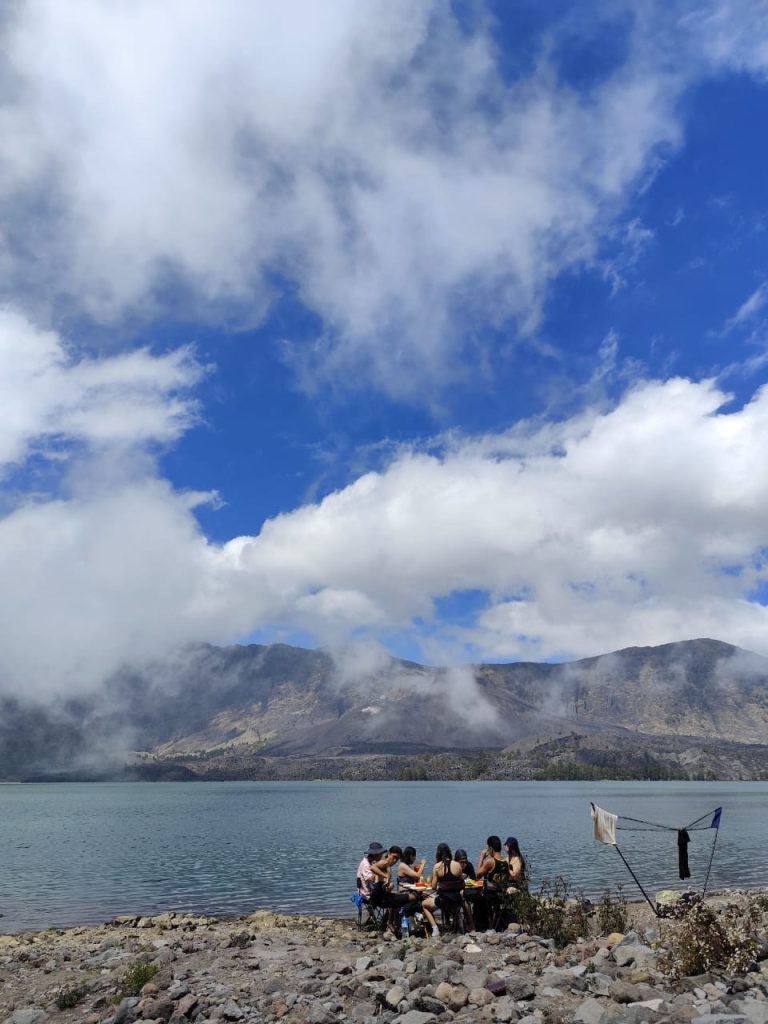Complete Guide to Conquering Mount Rinjani Hike in Lombok Island Indonesia

Mount Rinjani, located on the island of Lombok in Indonesia, is one of Southeast Asia’s most iconic and challenging treks. Standing tall at 3,726 meters (12,224 feet), it is the second-highest volcano in Indonesia, offering adventurers a unique blend of natural beauty, cultural richness, and a physical challenge that is truly rewarding. Whether you’re an experienced trekker or someone looking to push your limits, conquering Mount Rinjani is an achievement that will stay with you for a lifetime.

This guide will take you through everything you need to know about the Mount Rinjani hike, from preparation and planning to the actual experience on the mountain. By the end of this guide, you’ll be fully equipped to take on one of Indonesia’s most spectacular adventures.
- Understanding the Mount Rinjani Hike.
The Terrain and Environment
Mount Rinjani is a stratovolcano, meaning it has steep slopes made up of layers of hardened lava, tephra, and volcanic ash. The trek is known for its diverse terrain, which ranges from lush forests at the base to barren volcanic rock near the summit. Along the way, you’ll encounter a variety of ecosystems, including tropical forests, savannahs, and alpine meadows. The caldera, Segara Anak, is a breathtaking sight, featuring a stunning crater lake and a smaller active cone, Gunung Baru Jari.

The Challenges
The Mount Rinjani hike is not for the faint-hearted. It requires physical endurance, mental toughness, and a reasonable level of fitness. The trails can be steep and rugged, with loose rocks and slippery paths. Altitude sickness is another challenge, as the air gets thinner as you ascend. However, with proper preparation, the challenges can be overcome, making the experience all the more rewarding.
- Planning Your Mount Rinjani Hike
Best Time to Trek Mount Rinjani
The best time to hike Mount Rinjani is during the dry season, which runs from April to October. During this period, the weather is generally stable, with clear skies and less chance of rain, making the trails safer and the views more spectacular. The peak trekking season is from June to August, so if you prefer a quieter experience, consider going in the shoulder months of April, May, or September.
Choosing the Right Route
There are several routes to reach the summit of Mount Rinjani, each offering a different experience:
- Senaru Route: This is the most popular route, starting from the village of Senaru. It is a longer and more gradual ascent, taking you through dense rainforests and offering stunning views of the crater lake.
- Sembalun Route: This route starts from the village of Sembalun and is the preferred route for those who want a faster, more direct ascent to the summit. The trail is steeper but offers wide-open views and is less forested.
- Torean Route: This is a lesser-known and less crowded route that takes you through scenic waterfalls and rivers. It’s a great option for those looking for a more adventurous and off-the-beaten-path experience.
Hiring a Guide
While it is technically possible to trek Mount Rinjani without a guide, it is highly recommended to hire one. The terrain can be challenging and confusing, and having a local guide ensures not only your safety but also enriches your experience. Guides can provide valuable insights into the local culture, flora, and fauna, and they also help in arranging permits, accommodation, and transportation.
- Preparing for the Hike
Physical Fitness
Mount Rinjani is a demanding hike, and being physically prepared is crucial. It is recommended that you start training at least a few months before your trek. Cardiovascular exercises like running, cycling, or swimming will help improve your stamina. Strength training, especially focusing on your legs and core, will prepare you for the steep climbs and descents. Hiking with a loaded backpack on varied terrain will also simulate the conditions you’ll face on Rinjani.
Mental Preparation
Mental preparation is just as important as physical readiness. The hike can be tough, especially when the altitude kicks in, and the summit push can be particularly grueling. Visualizing your success, staying positive, and breaking down the trek into manageable sections can help keep your spirits high. Remember, reaching the summit is as much about mental endurance as physical strength.
Gear and Packing List
Packing the right gear is essential for a successful Mount Rinjani hike. Here’s a basic list of what you’ll need:
- Backpack: A 40-60 liter backpack should be sufficient. Make sure it’s comfortable and has good support.
- Clothing: Layering is key. Bring moisture-wicking base layers, an insulating mid-layer, and a waterproof and windproof outer layer. Don’t forget a hat, gloves, and a buff for the cold summit.
- Footwear: Sturdy, broken-in hiking boots with good ankle support are a must. Bring extra socks to keep your feet dry.
- Camping Gear: If your trek includes camping, your guide will typically provide tents and sleeping bags, but check in advance. Bring a lightweight sleeping pad and a compact pillow for added comfort.
- Hydration: Carry at least 2-3 liters of water. A hydration bladder is convenient, as it allows you to drink without stopping. Also, bring water purification tablets or a filter.
- Nutrition: Pack high-energy snacks like nuts, dried fruits, and energy bars. Your guide will typically provide meals, but it’s good to have extra snacks for energy boosts.
- Headlamp: Essential for early morning summit pushes.
- First Aid Kit: Include essentials like blister treatment, pain relievers, antiseptic wipes, and any personal medications.
- Sun Protection: Sunscreen, sunglasses, and a wide-brimmed hat are crucial to protect against the intense sun at higher altitudes.
- Trekking Poles: These can reduce the strain on your knees and provide stability on uneven terrain.
- The Experience: Day-by-Day on Mount Rinjani
Day 1: Starting the Journey
Your journey usually begins early in the morning from either Senaru or Sembalun. After registering at the Rinjani Information Center and meeting your guide, you’ll start your ascent. The first day’s hike is usually through lush tropical forests where you can spot monkeys, birds, and other wildlife. The trail gradually becomes steeper as you ascend, and after several hours of trekking, you’ll reach the first base camp. Here, you’ll set up camp for the night, enjoy a hearty meal, and prepare for an early start the next day.
Day 2: Reaching the Summit
The second day is typically the most challenging but also the most rewarding. Depending on your itinerary, you’ll wake up as early as 2 AM to begin the summit push. The trail to the summit is steep and covered in loose volcanic scree, making it difficult to maintain your footing. The air is thin, and the cold can be biting, but as you inch closer to the summit, the anticipation builds. Reaching the summit at sunrise is an unforgettable experience. The panoramic views of Lombok, Bali, and the surrounding islands are breathtaking. After spending some time at the summit, you’ll descend back to the base camp for breakfast.
Day 3: Exploring the Crater Rim and Descent
On the third day, you’ll have the chance to explore the crater rim and descend to the crater lake, Segara Anak. The descent can be steep, but the beauty of the lake and the hot springs that surround it make the effort worthwhile. After enjoying some time at the lake, you’ll begin the descent back to the starting point of your trek. The descent can be hard on the knees, so trekking poles can be helpful.
Alternative Itineraries
If you’re short on time, there are 2-day itineraries that focus on the summit without descending to the lake. Conversely, longer 4-day itineraries allow for a more relaxed pace and additional exploration around the crater lake.
- Safety and Environmental Considerations
Altitude Sickness
Altitude sickness can be a serious concern on Mount Rinjani, especially as you approach the summit. Symptoms include headaches, nausea, dizziness, and shortness of breath. To minimize the risk, it’s important to ascend slowly, stay hydrated, and take breaks as needed. If symptoms worsen, it’s crucial to descend to a lower altitude immediately.
Environmental Stewardship
Mount Rinjani is a protected area, and it’s important to practice Leave No Trace principles. This means packing out all your trash, minimizing your impact on the environment, and respecting local wildlife. The increasing popularity of the hike has led to environmental challenges, so every trekker’s effort counts in preserving this beautiful landscape for future generations.
Cultural Respect
The people of Lombok have deep spiritual connections to Mount Rinjani, considering it a sacred place. Respect local customs and traditions, and be mindful of your behavior, especially in the presence of local villagers. Your guide can provide insights into the cultural significance of various sites on the mountain.
- After the Trek: Recovering and Exploring Lombok
After completing the Mount Rinjani hike, you’ll likely need some time to rest and recover. Consider spending a few days exploring Lombok’s other attractions. The island is home to beautiful beaches, waterfalls, and traditional Sasak villages. The Gili Islands, just off Lombok’s northwest coast, are also a popular destination for post-trek relaxation, offering white sandy beaches, crystal-clear waters, and excellent snorkeling and diving opportunities.
- Final Tips for a Successful Mount Rinjani Hike
- Start Early: Begin your trek as early as possible each day to take advantage of cooler temperatures and to ensure you have plenty of daylight.
- Stay Hydrated: Drink plenty of water, even if you don’t feel thirsty. Dehydration can contribute to altitude sickness and fatigue.
- Listen to Your Body: If you start to feel unwell, take a break or consider descending to a lower altitude. Pushing through severe symptoms can be dangerous.
- Enjoy the Journey: While the summit is a major highlight, don’t forget to enjoy the journey itself. The views, the people you meet, and the personal challenges you overcome are all part of what makes the Mount Rinjani hike so special.
Conclusion: A Life-Changing Adventure
Conquering Mount Rinjani is more than just reaching a summit; it’s about the journey, the challenges, and the personal growth that comes with it. The experience will test your physical and mental limits, but the rewards both the stunning natural beauty and the sense of accomplishment are truly unparalleled. Whether you’re an experienced mountaineer or a trekking enthusiast looking for your next challenge, Mount Rinjani offers an adventure that will stay with you forever.
If You’re Ready To Take On The Challenge of Mount Rinjani, or if you have any questions, feel free to contact us:
We look forward to helping you embark on this unforgettable adventure!